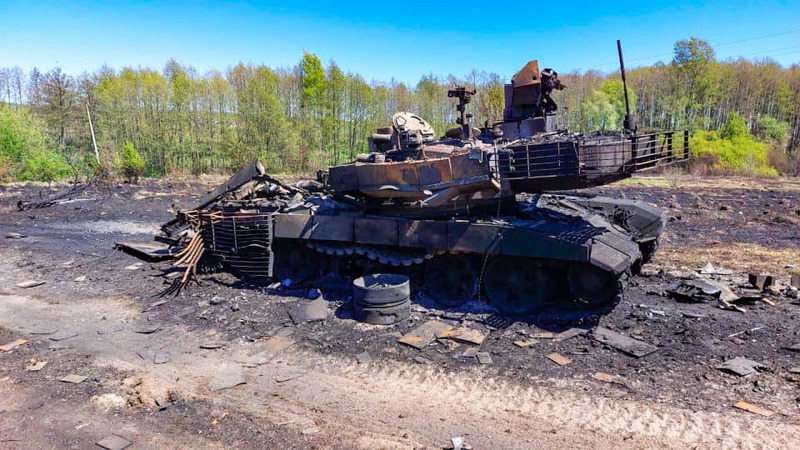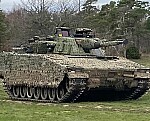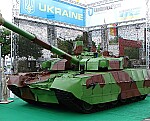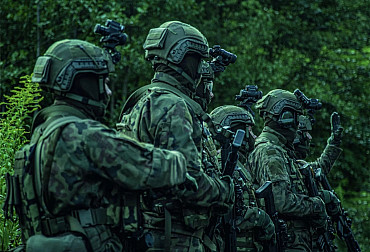T-90M is and remains the most modern Russian MBT deployed in Ukraine
The T-90 is a well known Russian Main Battle Tank developed in the early 1990s by Uralvagonzavod. It entered service in 1992. The T-90M is its modernisation carried out in 2010. The T-90M entered service in 2020, and currently is being the most modern Russian MBT in Russia’s war on Ukraine. So far oryxspioenkop.com documented loss of 36 T-90A’s and T-90S‘s, and 95 T-90M’s.

The T-90 is named Vladimir after its builder, Vladimir Potkin. It is an evolution of the T-72B line of tanks. The tank is equipped with a fire control system derived from the T-80 tanks. The T-90A model has a welded turret with a larger interior volume. It offers an excellent compromise between operational capability and price. It has been exported to various countries and manufactured under licence in India under the name Bhishma.
In 2017, the UKBTM design office of the Uralvagonzavod consortium developed the version of the modernised T-90M Main Battle Tank. It was developed as part of the Proryv-3 programme to modernise the Russian armed forces' entire fleet of T-90 and T-90A battle tanks. The T-90M adopts most of the systems of the T-90MS version developed for the export market.
The contract for the production of the first thirty T-90M tanks was signed between the Russian Ministry of Defence and the manufacturer UVZ, Uralvagonzavod, on 24 August 2017 during the Army-2017 exhibition. Ten of those tanks were to be newly produced and twenty upgraded from the T-90A tanks already in service. On 21 August 2018, another contract was signed for the modernisation of thirty T-90s to T-90M level. The 28 June 2019 contract provides for the modernisation of a further one hundred tanks. And more followed.
The T-90M has received the 2A82-1M 125mm gun with a length of 56 calibres, identical to the T-14 Armata tank, the Kalina fire control system and the 12.7mm remotely operated roof gun. The T-90M is integrated into the digitised battlespace, with the ability to transmit information in real time. The T-90M's protection is enhanced by additional pronounced V-shaped armour, Relikt dynamic armour and anti-RPG grids. The Relikt modular dynamic protection system deflects enemy shells one metre away from the tank. In the lower part of the turret and at the rear, screens placed under a grid serve as protection, and the combat compartment is protected by an anti-shrapnel lining. The tank's radar signature is significantly reduced compared with the basic model.
The ammunition and fuel stores are optimised to reduce sensitivity to enemy fire. In addition to the standard ammunition, the T-90M has received three types of ammunition specially designed for it. The first of these is the Vacuum-1 sub-calibre anti-armour ammunition with a depleted uranium core. According to the designers, during flight the projectile rises at a speed of 1980 metres per second and can penetrate one metre of tank armour. The second is a Telnik fragmentation munition that can be detonated remotely by the tank's crew. And the third is a Sprinter guided jet missile – its flight can be corrected in the process.
To increase its dynamic capabilities and offset the increased weight, the tank has been fitted with a V-92S2F engine producing 1,130 bhp. The first batch of T-90Ms was delivered in April 2020 to the 2nd Guards Mechanised Infantry Division "Tamanskaya", part of the 1st Guards Armoured Army of the Western Military Region.
Armament
- Main Gun: 125 mm 2A82-1Mx56 calibre
- Coaxial machine gun: 7.62 mm
- Machine gun: 12.7 mm
Technical specifications
- Crew: 3
- Engine: V-92S2F, 1,130 bhp
- Speed : 70 km/h
- Weight: 48 t
Dimensions
- Chassis length: 6.86 m
- Length with barrel: 9.53 m
- Width: 3.46 m
- Height: 2.23 m
Traditionally, it was accepted that the tank was the tank's worst enemy. Until recently, however, many expected that the effectiveness of modern anti-tank missiles would spell the end of the tank. While anti-tank missiles have proved their effectiveness in combat in Ukraine, they have in no way called into question the need for the tank, which remains a unique compromise between protection, mobility and firepower, the only one capable of providing certain options in a war frozen by artillery and largely neutralised air power. While the missile threat was recognised by both Russian and Ukrainian general staffs, neither of them, nor the Western backers in Kyiv, had anticipated the crucial role that drones would play in this conflict, both in terms of de-populating the battlefield and using them to carry out strikes beyond the line of sight.
Russian designers are now applying new features to the 2024 version of the T-90M tank, based on lessons learned from combat operations. This includes the placement of new professionally designed and factory-built protection on the vehicle's turret. This should increase the tank's protection against drone attacks, stand-off munitions and missiles attacking the tank's upper parts. New additional cover and a more durable netted cage are now being installed on and around the turret. Another change has affected the tank's frontal armour protection. This has been upgraded with a new type of more robust dynamic protection.
The overall tank protection design of the new T-90M has undergone various improvements. A number of innovations were also reportedly made to the fire control system, sights, rangefinder, night vision cameras and engine parts. All this is intended to provide the crew with an accelerated flow of information and enable them to react optimally and quickly to a situation. The basic problem of the further development of the T-72-class tank is primarily the lack of internal space with which the designers have to constantly wage a relentless battle. Simply put, some improvements always create a problem elsewhere in the design.










